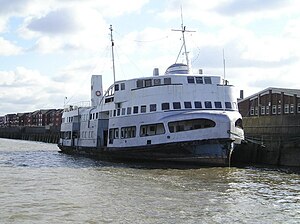51°29′43.41″N 0°2′34.80″E / 51.4953917°N 0.0430000°E
 Royal Iris on the Thames in 2009[1]
| |
| History | |
|---|---|
| Name | 1950 onwards: Royal Iris |
| Owner | James Jegede |
| Operator |
|
| Port of registry | 1950 onwards: Liverpool |
| Builder | William Denny and Brothers, Dumbarton |
| Yard number | 1448 |
| Launched | 8 December 1950 |
| Maiden voyage | May 1951 |
| Out of service | 12 January 1991 |
| Identification | IMO number: 5301332 |
| Status | Derelict |
| General characteristics | |
| Tonnage | 1,234 GT |
| Length | 48.46 m (159 ft 0 in) |
| Beam | 14.63 m (48 ft 0 in) |
| Draught | 2.74 m (9 ft 0 in) |
| Installed power | 4 x Ruston & Hornsby diesel engines |
| Propulsion |
|
| Speed | 12 knots (22 km/h; 14 mph) |
The MV Royal Iris is a twin screw, diesel-electric, Mersey Ferry. The vessel was built by William Denny & Brothers of Dumbarton (Yard No. 1448) and launched in December 1950, costing £256,000.
The engines were produced by Ruston & Hornsby Metropolitan-Vickers. Propulsion: 4 oil 4SA, each six cylinders driving four generators, each 300 kW/300v DC-connected to two electric motors, each 730shp and 2 shafts. The maximum speed is 12 knots. The ship measured 1,234 GT. Length is 159 feet long and 48 feet wide, with a draught of 9 feet.[2] At least during the first decade of its life, the ship's diesel-electric propulsion made it more economical to run than the other vessels in the fleet.[3]
Since 2002, the vessel has been laid up in a berth on the River Thames, close to the Thames Barrier in Woolwich. As of 2022, the ship continues to sit derelict and half submerged at its moorings.[4]
- ^ Picture by permission of Keith Chesworth
- ^ Stuart Cameron; Bruce Biddulph, Royal Iris, Shipping Times, archived from the original on 29 August 2016, retrieved 8 February 2009
{{citation}}: CS1 maint: unfit URL (link) - ^ Maund, T.B.; Jenkins, Martin (2003), Mersey Ferries: Volume 2 - The Wallasey Ferries, Black Dwarf Publications, ISBN 1-903599-08-3
- ^ Wiggins, Dan (2 May 2022). "Abandoned ferry rusting on the Thames that carried the Queen into Liverpool". MyLondon. Retrieved 20 June 2022.